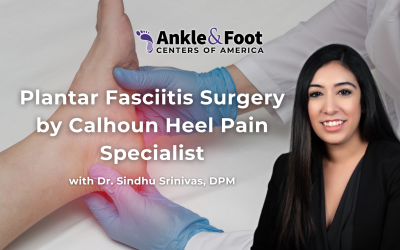Heel pain is a common presenting symptom to a foot and ankle clinic. Heel pain could be chronic (gradual onset) or acute (usually due to trauma or injury). There are many causes or etiologies of heel pain. Mechanical etiology of heel pain is the most common cause, with plantar fasciitis being the prevalent type of mechanical etiology. Plantar fasciitis (sometimes referred to as heel spur syndrome) is the chronic inflammation or non-inflammatory degeneration of a thick ligament (plantar fascia), which connects the heel bone to the toes. The plantar fascia’s main function is to support and stabilize the arch. Inflammation or non-inflammatory degeneration of the plantar fascia is caused by repeated micro tear of the fibers of this ligament, during walking. A common symptom of plantar fasciitis is pain to the medial band of the ligament after long periods of rest or with the first step in the morning.
Other forms of heel pain include; calcaneal stress fracture, heel pad syndrome, nerve entrapment (tarsal tunnel syndrome), and fat pad atrophy. Posterior heel pain, which is also a common presentation is podiatry clinics, could be Achilles tendonitis at its insertion to the heel bone (calcaneus bone), retro-calcaneal bursitis (inflammation of a fluid-filled sac between the Achilles tendon and heel bone), and Severe’s disease (calcaneal apophysitis) in children.
These different types of heel pain syndrome can be properly diagnosed and treated by a trained podiatrist. The doctor will, through extensive patient history and thorough physical examination, come up with the correct diagnosis. Appropriate imaging such as plain X-ray, Ultrasound, and advanced imaging like MRI, can be employed for proper diagnosis and treatment plan.
The first line of treatment for heel pain is typically conservative therapies, although resolution can take weeks to several months in some cases. Conservative treatment include; rest, offloading, eccentric stretching exercises, ice massage and oral anti-inflammatories. Some other treatment regime includes; taping/ strapping of the heel, corticosteroid injections, medical grade inserts/ custom made orthotics, night splints, and formal physical therapy. If attempted conservative therapies fail, some minimally invasive procedures like extracorporal shockwave therapy (ESWT), musculoskeletal ultrasound therapy, brisement (dry needling), protein rich plasma (PRP) injections, and TOPAZ (percutaneous thermo-debridement), can be employed. Open surgical transection of a portion of the plantar fascia is performed when all other treatment options fail. If nerve entrapment or tarsal tunnel syndrome is suspected and diagnosed, surgical procedures like radiofrequency ablation (RFA) or open nerve decompression is performed. Many studies have shown that most patients presenting with heel pain syndrome tend to do well with professionally guided conservative treatment, only a few recalcitrant cases require surgical intervention.
If you have any additional questions or concerns regarding heel pain syndrome or any other foot and ankle conditions, please call to schedule an appointment with Dr Osayamen Edigin for a thorough evaluation and appropriate treatment. You can call our Griffin office @ 770-227-0202 or our College Park office @404-768-3668 or click HERE to make an appointment now!






